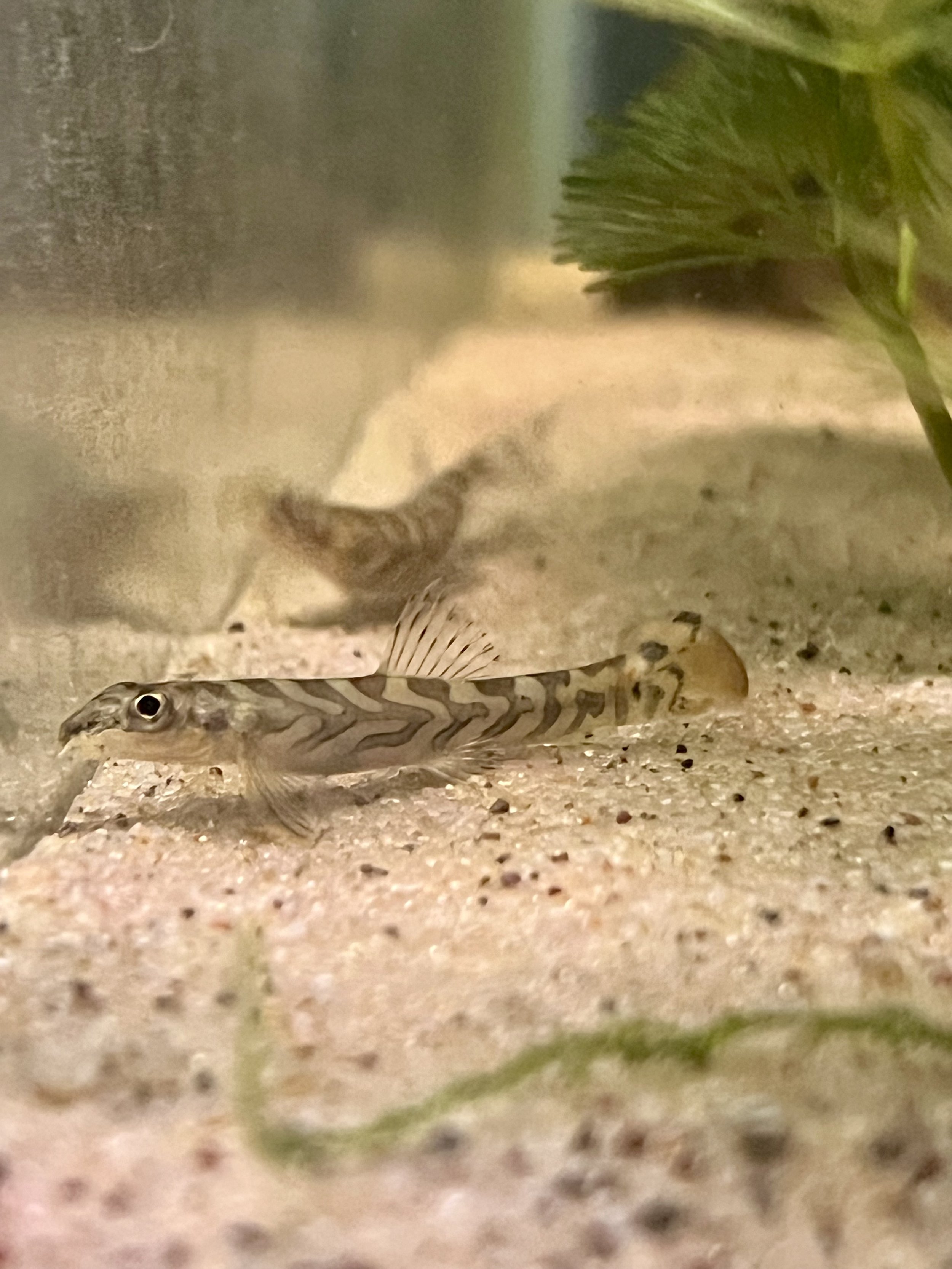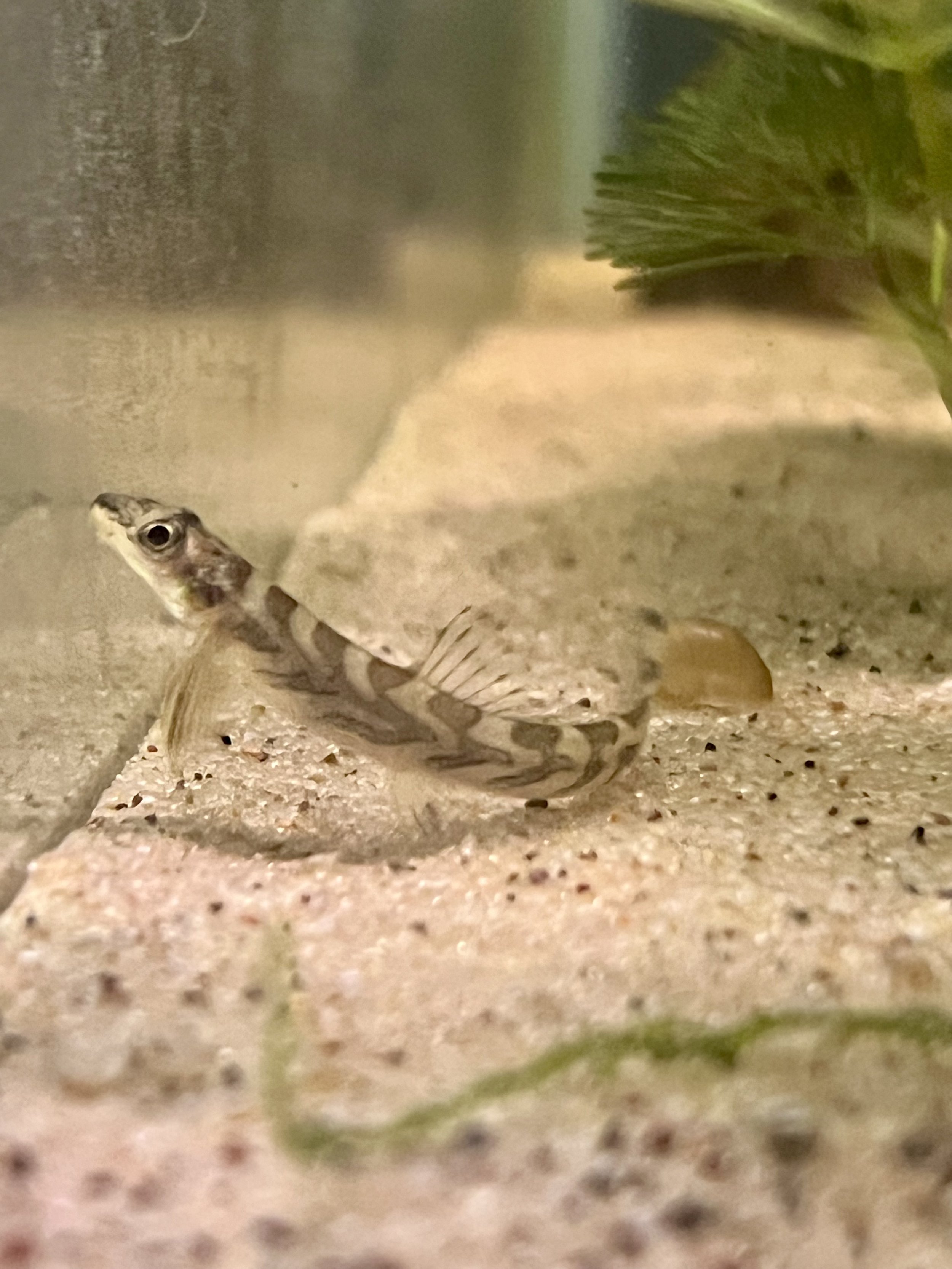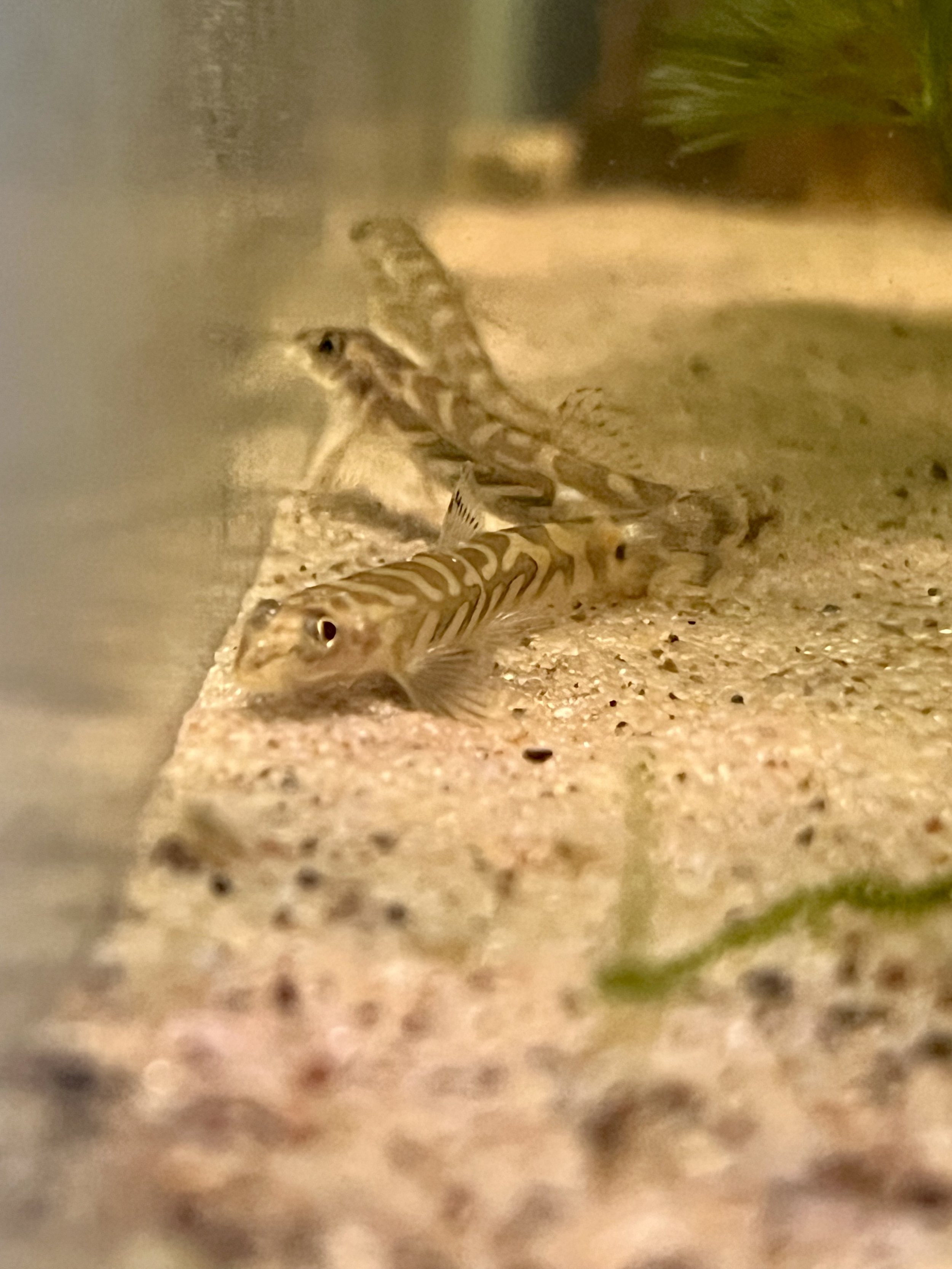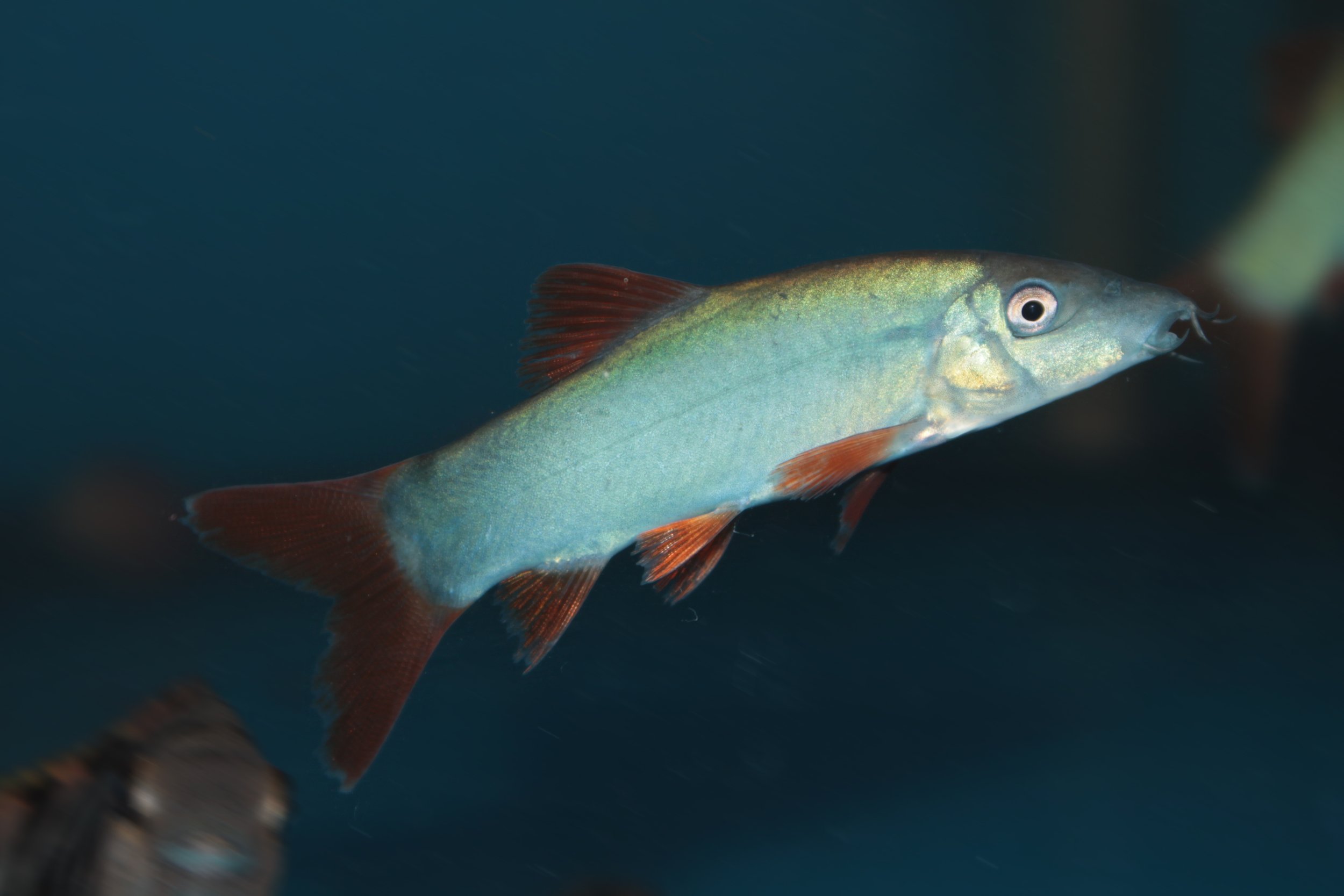 Image 1 of 3
Image 1 of 3

 Image 2 of 3
Image 2 of 3

 Image 3 of 3
Image 3 of 3




Batik Botia
The Batik Loach, scientifically known as Nemacheilus triangularis, is a fascinating species of freshwater loach, prized for its intricate pattern and active behavior. Native to the streams and rivers of southern India, particularly in the Western Ghats, this species thrives in fast-flowing, well-oxygenated waters with rocky substrates. Its striking “batik” pattern and relatively peaceful nature make it a popular choice for aquarists who appreciate small, active loaches that add both beauty and movement to their aquariums.
Physically, Nemacheilus triangularis is known for its distinctive, irregular patterns of dark, reticulated markings over a pale golden-brown or beige body, giving it the appearance of traditional batik fabric. The body is elongated and slender, typical of loach species, with a slightly flattened underside. The fins are usually clear with faint markings, and the loach has a pair of barbels near its mouth, which it uses to search for food along the substrate. Adult Batik Loaches typically reach a size of about 2.5 to 3 inches (6 to 7.5 centimeters) in length, making them well-suited for medium-sized aquariums.
In the aquarium, Batik Loaches thrive in tanks that replicate their natural environment. They prefer aquariums with plenty of hiding spots, such as rocks, caves, driftwood, and dense plant cover, which help them feel secure. These loaches are bottom-dwellers and will spend much of their time foraging along the substrate. A soft, sandy substrate is recommended to protect their delicate barbels. Because they are social fish, Batik Loaches should be kept in groups of at least five individuals to encourage natural schooling behavior and reduce stress. They are generally peaceful and can coexist with other similarly sized, non-aggressive fish, making them suitable for community tanks.
Water parameters for Nemacheilus triangularis should closely mimic the conditions of their native fast-flowing streams. They prefer slightly acidic to neutral water with a pH range of 6.5 to 7.5 and temperatures between 72 to 79°F (22 to 26°C). The water should be well-oxygenated, and a moderate to strong current is beneficial to replicate the flowing waters of their natural habitat. Regular water changes and efficient filtration are essential for maintaining clean, well-oxygenated water.
Feeding Batik Loaches is relatively easy, as they are omnivorous and will accept a variety of foods. They enjoy sinking pellets or wafers designed for bottom-feeding fish, as well as live or frozen foods such as bloodworms, brine shrimp, and daphnia. They may also graze on algae and will help clean up uneaten food from the substrate. Providing a varied diet will ensure they receive the nutrients they need to maintain good health and activity levels.
Breeding Nemacheilus triangularis in captivity is rare and has not been widely documented. In the wild, they likely breed during the rainy season, and replicating these conditions in the aquarium can be difficult. If breeding does occur, the fish are likely egg-scatterers, and the eggs would develop without any parental care. More research is needed to fully understand the breeding habits of this species in captivity.
Overall, the Batik Loach (Nemacheilus triangularis) is a visually appealing and active species that brings a touch of beauty and movement to freshwater aquariums. With their intricate patterns, peaceful nature, and suitability for community tanks, they are a great choice for aquarists who enjoy keeping loaches. When provided with the right environment and c
The Batik Loach, scientifically known as Nemacheilus triangularis, is a fascinating species of freshwater loach, prized for its intricate pattern and active behavior. Native to the streams and rivers of southern India, particularly in the Western Ghats, this species thrives in fast-flowing, well-oxygenated waters with rocky substrates. Its striking “batik” pattern and relatively peaceful nature make it a popular choice for aquarists who appreciate small, active loaches that add both beauty and movement to their aquariums.
Physically, Nemacheilus triangularis is known for its distinctive, irregular patterns of dark, reticulated markings over a pale golden-brown or beige body, giving it the appearance of traditional batik fabric. The body is elongated and slender, typical of loach species, with a slightly flattened underside. The fins are usually clear with faint markings, and the loach has a pair of barbels near its mouth, which it uses to search for food along the substrate. Adult Batik Loaches typically reach a size of about 2.5 to 3 inches (6 to 7.5 centimeters) in length, making them well-suited for medium-sized aquariums.
In the aquarium, Batik Loaches thrive in tanks that replicate their natural environment. They prefer aquariums with plenty of hiding spots, such as rocks, caves, driftwood, and dense plant cover, which help them feel secure. These loaches are bottom-dwellers and will spend much of their time foraging along the substrate. A soft, sandy substrate is recommended to protect their delicate barbels. Because they are social fish, Batik Loaches should be kept in groups of at least five individuals to encourage natural schooling behavior and reduce stress. They are generally peaceful and can coexist with other similarly sized, non-aggressive fish, making them suitable for community tanks.
Water parameters for Nemacheilus triangularis should closely mimic the conditions of their native fast-flowing streams. They prefer slightly acidic to neutral water with a pH range of 6.5 to 7.5 and temperatures between 72 to 79°F (22 to 26°C). The water should be well-oxygenated, and a moderate to strong current is beneficial to replicate the flowing waters of their natural habitat. Regular water changes and efficient filtration are essential for maintaining clean, well-oxygenated water.
Feeding Batik Loaches is relatively easy, as they are omnivorous and will accept a variety of foods. They enjoy sinking pellets or wafers designed for bottom-feeding fish, as well as live or frozen foods such as bloodworms, brine shrimp, and daphnia. They may also graze on algae and will help clean up uneaten food from the substrate. Providing a varied diet will ensure they receive the nutrients they need to maintain good health and activity levels.
Breeding Nemacheilus triangularis in captivity is rare and has not been widely documented. In the wild, they likely breed during the rainy season, and replicating these conditions in the aquarium can be difficult. If breeding does occur, the fish are likely egg-scatterers, and the eggs would develop without any parental care. More research is needed to fully understand the breeding habits of this species in captivity.
Overall, the Batik Loach (Nemacheilus triangularis) is a visually appealing and active species that brings a touch of beauty and movement to freshwater aquariums. With their intricate patterns, peaceful nature, and suitability for community tanks, they are a great choice for aquarists who enjoy keeping loaches. When provided with the right environment and c
The Batik Loach, scientifically known as Nemacheilus triangularis, is a fascinating species of freshwater loach, prized for its intricate pattern and active behavior. Native to the streams and rivers of southern India, particularly in the Western Ghats, this species thrives in fast-flowing, well-oxygenated waters with rocky substrates. Its striking “batik” pattern and relatively peaceful nature make it a popular choice for aquarists who appreciate small, active loaches that add both beauty and movement to their aquariums.
Physically, Nemacheilus triangularis is known for its distinctive, irregular patterns of dark, reticulated markings over a pale golden-brown or beige body, giving it the appearance of traditional batik fabric. The body is elongated and slender, typical of loach species, with a slightly flattened underside. The fins are usually clear with faint markings, and the loach has a pair of barbels near its mouth, which it uses to search for food along the substrate. Adult Batik Loaches typically reach a size of about 2.5 to 3 inches (6 to 7.5 centimeters) in length, making them well-suited for medium-sized aquariums.
In the aquarium, Batik Loaches thrive in tanks that replicate their natural environment. They prefer aquariums with plenty of hiding spots, such as rocks, caves, driftwood, and dense plant cover, which help them feel secure. These loaches are bottom-dwellers and will spend much of their time foraging along the substrate. A soft, sandy substrate is recommended to protect their delicate barbels. Because they are social fish, Batik Loaches should be kept in groups of at least five individuals to encourage natural schooling behavior and reduce stress. They are generally peaceful and can coexist with other similarly sized, non-aggressive fish, making them suitable for community tanks.
Water parameters for Nemacheilus triangularis should closely mimic the conditions of their native fast-flowing streams. They prefer slightly acidic to neutral water with a pH range of 6.5 to 7.5 and temperatures between 72 to 79°F (22 to 26°C). The water should be well-oxygenated, and a moderate to strong current is beneficial to replicate the flowing waters of their natural habitat. Regular water changes and efficient filtration are essential for maintaining clean, well-oxygenated water.
Feeding Batik Loaches is relatively easy, as they are omnivorous and will accept a variety of foods. They enjoy sinking pellets or wafers designed for bottom-feeding fish, as well as live or frozen foods such as bloodworms, brine shrimp, and daphnia. They may also graze on algae and will help clean up uneaten food from the substrate. Providing a varied diet will ensure they receive the nutrients they need to maintain good health and activity levels.
Breeding Nemacheilus triangularis in captivity is rare and has not been widely documented. In the wild, they likely breed during the rainy season, and replicating these conditions in the aquarium can be difficult. If breeding does occur, the fish are likely egg-scatterers, and the eggs would develop without any parental care. More research is needed to fully understand the breeding habits of this species in captivity.
Overall, the Batik Loach (Nemacheilus triangularis) is a visually appealing and active species that brings a touch of beauty and movement to freshwater aquariums. With their intricate patterns, peaceful nature, and suitability for community tanks, they are a great choice for aquarists who enjoy keeping loaches. When provided with the right environment and c






